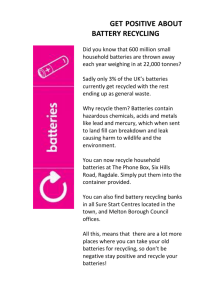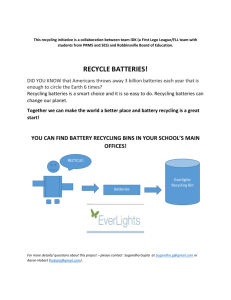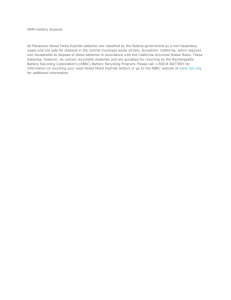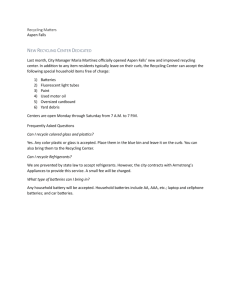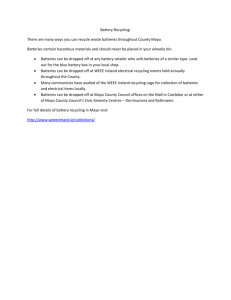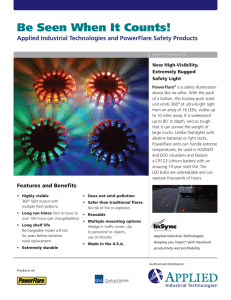Inventor file Farouk Tedjar
advertisement
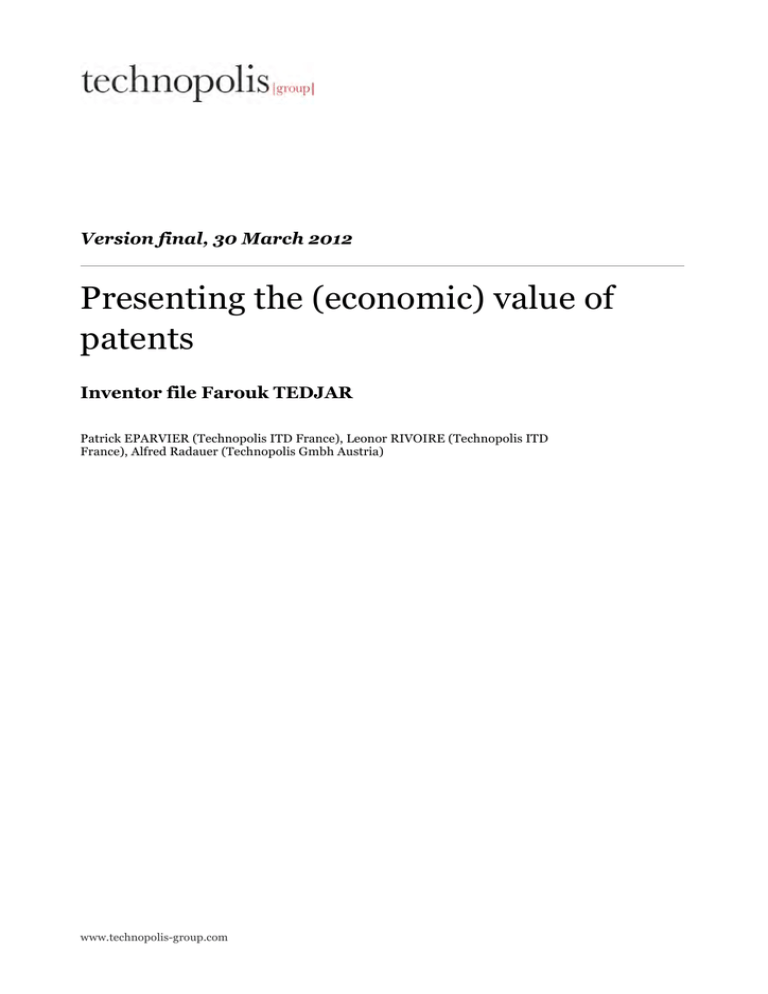
Version final, 30 March 2012 Presenting the (economic) value of patents Inventor file Farouk TEDJAR Patrick EPARVIER (Technopolis ITD France), Leonor RIVOIRE (Technopolis ITD France), Alfred Radauer (Technopolis Gmbh Austria) www.technopolis-group.com 1. The invention 1.1 Historic account The invention is related to a method for recycling mixed batteries and cells comprising lithium-based anodes. The solution developed by the scientists Dr Farouk Tedjar and Jean-Claude Foudraz is a way to recycle these batteries and recover the valuable metals they contain. Frank Tedjar was influenced in his choice of profession by his father, an electrician in Sétif, Algeria. Plus Farouk Tedjar always had a passion for electrochemical phenomena: “When I was a kid, I used to put batteries in bleach, he says. I liked watching chlorine fumes. It was dangerous and funny”1. Now he continues his experiments to recycle cells and batteries, with on eye on other waste to be recovered: flat screens and photovoltaic panels. After graduating from the Grenoble Institute of Technology, Dr Farouk Tedjar worked as an engineer in an Algerian factory producing cells and batteries. Then he was appointed director of the Institute of Chemistry (Sétif University). In the 1990s, he decided to go back to France as a researcher to work at the Grenoble Institute of Technology2. After working for 20 years in the field of battery improvement, his interest was naturally focussed on recycling. His objective was to find an environmental solution to battery and cell recycling without creating new environmental problems. As he says himself: “Who knows better how to recycle a battery than someone who knows how to produce a battery?” In 1993, he created a company called Recupyl, which was incubated at the Grenoble Institute of Technology. Mr Tedjar became the President of the company, which uses an urban mining strategy to recover batteries from old electronic devices. The chemical solution occurred to him in 1995 after having read an article in support of the idea that waste is a mine for tomorrow. In 2005, with fellow scientist Jean-Claude Foudraz, he developed a new process to recover 98% of all the metals contained in a lithium-ion battery. Thanks to this new method, they succeeded in recovering the following components from one metric tonne of batteries: 130 kg of cobalt, 290 kg of stainless steel, 85 kg of lithium, 80 kg of copper and 240 kg of paper and plastic waste. Mr Tedjar underlines that the losses throughout the system are very low. The company benefited in 2006 from investments from a private equity firm (ALOE Private Equity). Recupyl is now a fast growing French company. The company has carved out a leading position in the global battery & accumulator recycling market and has now operations in France, Poland, , Spain, Singapore, and the US. Recupyl develops and operates processes based on research conducted by Dr. Farouk Tedjar at the Grenoble Institute of Technology. This recycling method is Mr. Tejar´s answer to a number of sustainability challenges, such as limited CO2 emissions, low energy consumption, reduced environmental 1 Farouk Tedjar recycle piles et batteries en puisant dans les "nouvelles mines urbaines" LE MONDE, 31 December 2008 2 Farouk Tedjar recycle piles et batteries en puisant dans les "nouvelles mines urbaines" LE MONDE, 31 December 2008 Technopolis Forschungs- und Beratungsgesellschaft m.b.H. Rudolfsplatz 12/11 A-1010 Wien Austria T +43 1 503 9592 12 F +43 1 503 9592 11 E info.at@technopolis-group.com www.technopolis-group.com impact and high recycling rates with impact on resource conservation for strategic metals.3 1.2 Technological features of the invention Protecting the environment, which includes collecting and recycling waste, has become a global environmental issue. With the increasing number of devices using portable technology (mobile phones, laptops, etc.), disposing of the rechargeable batteries that power these devices creates a very large amount of waste. The increase in portable electronic products has resulted in an expansion of the cell market, and the autonomy requirements using sources with high energy density have boosted the market for cell phone batteries, in particular the lithium system4. Despite the various assets related to their performance, lithium systems are still a source for products with recognized harmful environmental impact, including: i) heavy metals (cathodic materials); ii) conducting salts with fluorine, arsenic or sulfonated compound base; iii) organic solvents; and iv) very reactive alkaline metal. Beyond the environmental implications, lithium-ion batteries contain potentially scarce substances, such as cobalt, which has been identified by the European Commission as a critical raw metal. Farouk Tedjar and Jean-Claude Foudraz developed a new process to recover 98% of all the metals contained in a lithium-ion battery. Their invention and associated patent entitled Method for the recycling of mixed batteries and cells comprising lithium based anodes (2007) deals with a method for treating all types of lithium anode batteries and cells via a hydrometallurgical process at room temperature. This method is used to treat, under safe conditions, cells and batteries including a metallic lithium anode, or an anode containing lithium incorporated in an anode inclusion compound, whereby the metallic casings, the electrode contacts, the cathode metal oxides and the lithium salts can be separated and recovered5. This invention is intended to provide a treatment method for recycling lithium systems without any pollution transfer and with maximum recovery to ensure conversion of the resource into added-value compounds6. The new method developed by Dr Tedjar and Mr Foudraz includes dry crushing at room temperature in an inert atmosphere, treatment by magnetic separation and densimetric table, followed by aqueous hydrolysis, to recover the lithium in carbonate or lithiophosphate form, an anion of electrolyte salt and a concentrate comprising at least one metal of said cathode. The recycling technology developed by Dr Tedjar and Foudraz is based on the following processes: 1. Recycled batteries are separated from other kinds of non-lithium batteries. 2. Lithium-ion are shredded under inert gases. 3. Crushed material is put through a woven mesh screen with a high induction magnet. 4. The next step in the process consists of separating fine metal oxides and carbon from the rest of the materials. Then, the fine metal oxides and carbon are 3 http://www.recupyl.com/94-corporate.html 4 United States patent Application Publication, Tedjar et al. ,Pub.No.: US 2007/0196725 A1, August 23, 2007 5 United States patent Application Publication, Tedjar et al. ,Pub.No.: US 2007/0196725 A1, August 23, 2007 6 United States patent Application Publication, Tedjar et al. ,Pub.No.: US 2007/0196725 A1, August 23, 2007 submerged in an alkaline, non-acidic solution that neutralises the battery electrolytes and removes ferrous and non-ferrous metals. 5. The solution is then filtered, and carbon is recovered and pressed into moist sheets of carbon cake. 6. Cobalt is removed using electrolysis according to one claim and as cobalt oxide according to another claim 7. Lithium in the solution is converted into technical-grade lithium carbonate. The fine powder is used along with cobalt to make lithium cobalt oxide, which operates in the same way as the cathode in lithium-ion batteries. 8. The anion of lithium salts are also recovered making this technology unique in allowing access to lithium salt anion. Several different methods for recycling the components in lithium-ion batteries already existed, particularly those based on extreme heating or cooling, but they produce limited results. The recycling method invented by Dr Tedjar and Mr Foudraz has the advantage of requiring no extreme heating or cooling, therefore avoiding green house gas emissions. Compared to competing technologies, it consumes significantly less energy. 2. The Market 2.1 Overall market prospects The market for recycling of batteries is a very young and still a small one, in particular when it comes to Li-based batteries. According to EBRA – the European Battery Recycling Association – there were only 1,493 tonnes of Li-based batteries recycled in 2010 (which, however, is an increase of 36% compared to 2009). Most of the recycled batteries in 2010 (1,196 tonnes) address portable secondary (i.e., rechargable) Li batteries, while Li-primary batteries were recycled to the extent of 297 tonnes. By comparison, there were more than 37,000 tonnes of batteries of all types recycled (excluding Zn-Pb batteries used in cars). The figures of EBRA are said to represent around 85% of the EU market.7 Currently, “...there is...little economic need to recycle Li-batteries”.8 Lithium is cheap, and modern Li-batteries are said to be safe for landfills and incinerations. The situation, however, is poised to change with higher usage of electrically driven cars and hybrid propulsion. For the U.S., there are estimates that “...by 2016 the market for Libattery recycling may be as large as US$ 2 billion, with more than half a million end-of-life electric vehicle’s battery packs becoming available for recycling through the waste-stream.” Other sources put the market size to US$ 1 billion in 2016. To make electrical driving fully clean-tech, there are broad activities by both industry and policy to address the issue of recycling early on. Regulation plays a key role, such as the Battery Act in the U.S. or the Battery Directive in Europe. The Directive from 2004 shifts responsibilities form users to producers of batteries and requires a recycling target between 50% and 75%. 7 EBRA (2010): 2010: a year of contrasts: further growth in the primary sector but temporary decrease in the Li-Ion recycling market, http://www.ebrarecycling.org/sites/default/files/EBRA%20PR-%20BatteryStatistics_year2010.pdf 8 HybridCars.com (2009): Birth of Industry to Recycle Lithium Auto Batteries, http://www.hybridcars.com/environment/birth-industry-recycle-lithium-auto-batteries-26047.html Technopolis Forschungs- und Beratungsgesellschaft m.b.H. Rudolfsplatz 12/11 A-1010 Wien Austria T +43 1 503 9592 12 F +43 1 503 9592 11 E info.at@technopolis-group.com www.technopolis-group.com There is fairly little information available on the current economic success of Recupyl. After a first finance round in 2006, Recupyl SAS received some additional € 14.5 million in 2008 for the next phase of commercialisation of the technology by a number of venture capital firms, indicating considerable expectations for the technology.9 The company employed some 20 staff in Domene, France, in 2010.10 It has recycling facilities operating in Singapore, France, Spain and the UK. A joint venture with U.S. Battery Inc. in Michigan was formed to enter the U.S. market. There, it will meet competition from a number of firms, most notably Toxco. Toxco has been the leading battery recycler in the U.S. and received some US$ 9.5 million from the Department of Energy (DoE) to build “...America’s first recycling facility Li-vehicle batteries”11. In Europe, there are some 40 firms engaged in battery recycling.12 A lack of recycling capacity for Li-primary batteries can be foreseen in the future if their market share continues to increase13. Lithium-ion batteries power an estimated 2 billion mobile phones worldwide, often replaced every 18 months. Lithium-ion batteries are also contained in most of the nearly 400 million laptops sold each year. Together with cell phones, the laptops account for the lion’s share in the $12 billion lithium-ion market. Recupyl estimates the number of batteries to be recycled up to 200 000 tons per year. 2.2 The business developed by RECUPYL With its innovative battery recycling solutions, Recupyl aims to become a trusted partner in battery collection and recycling. Recupyl's business is built on three main pillars14: • Environmental protection; • Regulatory compliance; • Intellectual property protection. Thanks to its R&D effort, Recupyl has become an expert in the recycling of lithium batteries. R&D staff continues to develop solutions for the batteries of the future. Recupyl is also part of two French competitiveness clusters, AXELERA (Rhone Alpes Minalogic (Rhone Alpes) and Tenerrdis (Rhône-Alpes), and leads two collaborative research projects (Ellipsup , PROCYiON²). The company has formed partnerships with the manufacturers of batteries and electric vehicles in order to design eco-friendly batteries that can be more easily recycled and to develop high-yield processes to recycle next-generation batteries. Recupyl has the ambition of becoming a global leader in the field as well as other recycling areas such as: photovoltaic cells, flat screens, electric arc furnace dust, fly ash. Recupyl received €14,5 million in 2008 for a new phase of commercialisation of its technology by a number of venture capital firms, boding well for the future of the technology. In 2010, the company employed around 20 members of staff and had recycling facilities operating in France, Poland, , Spain, Singapore and the US. Indeed, since 2007, Recupyl has established five subsidiaries in Singapore, the US (Michigan), 9 http://www.prnewswire.co.uk/cgi/news/release?id=243638 10 http://www.recupyl.fr/87-13-3-article-magazine-quot-presences-quot-mars-2010.html 11 http://www.recupyl.fr/87-14-3-recupyl-and-battery-solutions-the-united-states.html 12 http://www.epbaeurope.net/recycling.html 13 EBRA PR-BatteryStatistics, Year 2010 14 http://www.recupyl.com/95-why-choose-recupyl.html Poland, Spain, and Italy. A first lithium-ion battery treatment plant was opened in April 2007 through a joint venture with Tes-Amm Singapore Pte Ltd, a specialist in electric and electronic waste recycling. This joint venture serves industries ranging from computer manufacturing and assembly to battery manufacturing, mobile phone production, and local battery collection15. Recupyl Battery Solutions, LLC (RBS Metals LLC) was founded in 2009 as a joint venture between Recupyl SAS and Battery Solutions Inc., a leading battery collector in the United States. RBS Metals LLC benefits from being located near manufacturers in the automotive industry - an advantage that will help Recupyl achieve its goal of becoming the industry's partner for hybrid and electric vehicle battery recycling. Moreover, in 2009, Recupyl joined forces with Zuo Sp. z.o.o. to create Recupyl Polska Sp. z o.o., a Poland based company specialised in the sorting of mixed batteries and the mechanical separation of alkaline and zinc-carbon battery materials. Eventually, Recupyl Espana S.L. and Recupyl-Relight SRL were respectively established in Spain and Italy. Recupyl now has a leading position in the global battery and accumulator recycling market. Its total annual sales amount to € 3 millions. 3. The role of the patent(s) and Intellectual Property Rights (IPR) 3.1 Motives for and benefits of patenting and employed IPR strategy The first patent filed by Mr Tedjar in 1993 resulted in incubation at the Grenoble Institute of Technology. The aim of the incubation was to develop further the technical development of the process. This patent was of high importance, since it triggered the R&D dynamics of Recupyl and made it possible to conduct research to improve this first invention. Recupyl's focus on innovation is backed by extensive R&D and a broad patent portfolio. Since Dr Tedjar’s and Foudraz’ invention, Recupyl developed recycling and recovery technologies for many other types of waste. The development of the company relied on a partnership agreement with the Grenoble Institute of Technology, giving it access to the material and human resources of the scientific centre of Grenoble in France. Based on its expertise in hydrometallurgy, Recupyl now owns 10 patents for treatment methods of a wide range of waste and constantly develops new technologies. The IPR strategy behind the invention of the method for recycling mixed batteries and cells including lithium-based anodes is based on a broad patenting process targeted to a large number of foreign countries. A specific budget is now supporting the company’s patents. For Recupyl, patenting is a way to secure and protect inventions against copies and to be comfortable with international expansion. This first patent resulted in 3 licenses (US, UK and Singapore), among which only one is yielding royalties (UK), the remaining two being in the form of partnerships (US and Singapore). In the UK, the license was sold with license fees. In Singapore and the US, the production line was sold together with the related license to Recupyl’s subsidiary companies, and returns on investment are made through remittance of dividends. Up until recently, the company preferred to create partnerships rather than license its technology. Royalties account for secured incomes. Partnership agreements are more 15 http://www.recupyl.com Technopolis Forschungs- und Beratungsgesellschaft m.b.H. Rudolfsplatz 12/11 A-1010 Wien Austria T +43 1 503 9592 12 F +43 1 503 9592 11 E info.at@technopolis-group.com www.technopolis-group.com complex to handle. However, partners have networks and relationships with companies owning batteries for recycling. Currently, the company is less keen on developing new partnerships. It prefers to wait and see how legislation will evolve in countries worldwide. The company carries out technology and legal watch activities in order to react to changes in legislation related to the recycling of Lithium-ion batteries. New patents are currently being considered, in particular improvement patents to increase the recycling rate and recover a maximum amount of material and components (such as solvents or plastics, for instance). 3.2 Patent statistics and patenting trends Recuply applied for the nominated patent in 2004, and was granted the patent in 2007. Patent protection spans some 20 countries in Europe plus a number of overseas countries including Japan, the U.S. and Australia. As broad geographical coverage of a patent is an indicator of patent value (based on the assumption that patent protection spanning several countries costs a lot, with the money being spent only after careful business considerations), this is a first indication that Recupyl´s patent is valuable. Since 1993, Recupyl has applied for a further 17 patents on different topics, seven times of which with the European Patent Office. Five of these patents were granted. Furthermore, patents were granted in the U.S. (3) and in France (14). The patents have been cited a total of 30 times by other patent applications, indicating that the technology has been recognised by industry players as relevant contribution. The significant role of Lithium Ion batteries (in 2008 alone Asian producers manufactured 3 billion pieces) as energy storage devices is reflected in a huge number of patent applications. ‘Lithium-Ion’ batteries were given its own class in the patent technology classification system (class ECLA Y02E60/12B). Since 1991, the year of the market introduction by Sony, there have been 28,229 patent applications to date in this class. On the topic of recycling of lithium ion batteries, there have been only a few patent families applied for (350) since 1980. Reflecting the fact that most Lithium Ion batteries manufacturers are located in Asia, we find also that most of the related recycling patent applications come from that area. Japan (148 applications) is ranking first, China (83) second. Patenting activity is still increasing in this field. 4. Overall assessment of the patent value and achievements The IPR strategy of the company was obviously to protect the invention but it was considered one of the three pillars of corporate strategy only. The second pillar corresponds to the continuous R&D efforts carried out by the company to strengthen the technology developed by the company and to adapt it to new potential markets. The R&D culture of the president of the company, Mr Tedjar, explained the early success of the company in developing and raising funds for its development. The company knows how important R&D is and how important patents are to protect inventions and to enable the development of the company. The third pillar contributing to the firm’s success was its ability to build up facilities worldwide and to act as a multi-national firm. The patent and the licenses sold provide the company with credibility towards foreign partners in foreign countries. Recupyl and its patents make the company a solid and trustworthy partner. The current value of the patent is limited. The current economic model of the company does not rely on the Lithium-ion related patent only. This patent generates few revenues. This is due to the fact that the existing batteries that are recycled are limited in size. The economic value of the patent will increase dramatically once automotive batteries have reached the end of their life; the life-cycle of the first automotive batteries will end in a decade. At this time, the current patent will provide Recupyl with an outstanding asset for capturing a large share of the market. The patent is likely to provide revenues in a shorter period of time, depending on unexpected events. For instance, according to the Chief for International Affairs of Recupyl, the company A123 had to recall 500 000 batteries because of a misalignment of a number of components in a Lithium-ion battery cell during the production process. This will inevitably put the emphasis on the recycling of these batteries. This can turn into an opportunity for the company in the US market. Technopolis Forschungs- und Beratungsgesellschaft m.b.H. Rudolfsplatz 12/11 A-1010 Wien Austria T +43 1 503 9592 12 F +43 1 503 9592 11 E info.at@technopolis-group.com www.technopolis-group.com
